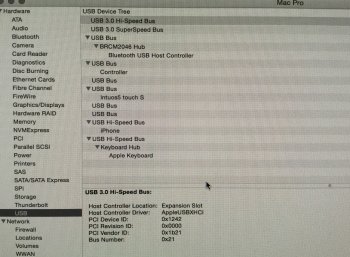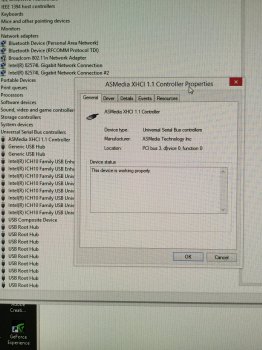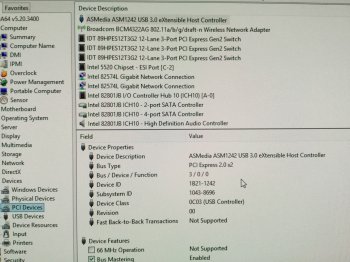In sleep mode these cards have an issue that they don't charge iPads and iPhones. I don't kno if that is the case with all USB cards.
Got a tip for us?
Let us know
Become a MacRumors Supporter for $50/year with no ads, ability to filter front page stories, and private forums.
USB 3.1 PCIe for cMP info repository
- Thread starter stmp
- Start date
- Sort by reaction score
You are using an out of date browser. It may not display this or other websites correctly.
You should upgrade or use an alternative browser.
You should upgrade or use an alternative browser.
What are your experiences with 3.1 cards under El Cap?
I tried Asus one today and as for now it seems to be useless. None of the drives I tried was recognized. So far tested only 3.0 pendrive and mSATA SSD via USB 3.1 adapter.
When put in slot 3 card runs x1. In slot 2 it's x2 like it should. It's listed simply as USB 3.0 in ASP (no Super Speed etc like in previous OS versions).
According to what SoyCapitan said, no USB 3.1 support in DP3.
I tried Asus one today and as for now it seems to be useless. None of the drives I tried was recognized. So far tested only 3.0 pendrive and mSATA SSD via USB 3.1 adapter.
When put in slot 3 card runs x1. In slot 2 it's x2 like it should. It's listed simply as USB 3.0 in ASP (no Super Speed etc like in previous OS versions).
According to what SoyCapitan said, no USB 3.1 support in DP3.
What are your experiences with 3.1 cards under El Cap?
I tried Asus one today and as for now it seems to be useless. None of the drives I tried was recognized. So far tested only 3.0 pendrive and mSATA SSD via USB 3.1 adapter.
When put in slot 3 card runs x1. In slot 2 it's x2 like it should. It's listed simply as USB 3.0 in ASP (no Super Speed etc like in previous OS versions).
According to what SoyCapitan said, no USB 3.1 support in DP3.
Mine is in slot 3. I don't know how to check link speed but it worked normally with an external SSD (a ****** old OCZ)
I don't know how to check link speed
Apple Menu bar>About this Mac>System Report...>PCI>Select device in the upper righthand pane and look at the link speed at the bottom righthand pane.
Apple Menu bar>About this Mac>System Report...>PCI>Select device in the upper righthand pane and look at the link speed at the bottom righthand pane.
'There was an error while gathering PCI Device Information'
Ahh, that is a problem then.
In fact I have been getting that message longer than I had the card. How do I fix it? Diagnostics says the system passed fine.
Do you have a non-Mac video card without an EFI modification?
Yep.
Slot 1 GTX 980 unflashed
Slot 2 GT120
Slot 3 ASUS USB 3.1
Slot 4 Sonnet Tempo Pro
Here is a screenshot of my USB tree. The ASUS card is showing as high speed and super speed.
Attachments
Naturally he has, otherwise it would show cards list.
Soy: use lspci to check link width
Do you use El Cap DP3?
Yosemite. I'm not booting back into El Cap until Nvidia drivers. Lspci has to be installed first right?
That doesn't work in Yosemite. Command not found.No, just open a terminal sesson and enter the command lspci then press enter
Yeah, I just found that out too...That doesn't work in Yosemite. Command not found.
Looks like you can add the command... Read here https://rampagedev.wordpress.com/more-guides/use-lspci-for-info/
Yeah, I just found that out too...
I heard LSPCI is a utility that has to be installed but I don't really want to install things into invisible directories. I'll check how to see lane speed in Windows.
I heard LSPCI is a utility that has to be installed but I don't really want to install things into invisible directories. I'll check how to see lane speed in Windows.
Look at the above post. I took it for granted that it was there already. I use it all the time in Linux and didn't realize it's something that would need to be installed in OS X.
Look at the above post. I took it for granted that it was there already. I use it all the time in Linux and didn't realize it's something that would need to be installed in OS X.
Let's try with AIDA64 first
I think that if you get one reading under Windows, it's doesn't necessarily mean that you'll get the same in OS X.
If you really want to put in the effort, and you don't want to install the lspci package. You could probably just pull the unsupported nVidia card (since you have a second on that is supported for boot screens), run the test, then put the card back in. It may be more than you want to do but it should resolve the issue long enough for a quick look.
If you really want to put in the effort, and you don't want to install the lspci package. You could probably just pull the unsupported nVidia card (since you have a second on that is supported for boot screens), run the test, then put the card back in. It may be more than you want to do but it should resolve the issue long enough for a quick look.
Windows should retrieve the same PCIE information for all devices except for the graphics card which will be forced to run at 1.0 because of the EFI. The number of lanes should always be the same no matter the OS unless the device has failed to negotiate a correct link.
Here are my screenshots. Device manager says the Asmedia XHCI 1.1 driver is installed and the card is in slot 3. This driver will be tested when a USB 3.1 device is available. Aida64 says the card is on PCIE 2.0 with x2 lane width but it reported the device as USB 3.0, probably because Aida64 doesn't yet recognise 3.1 chipsets.
Here are my screenshots. Device manager says the Asmedia XHCI 1.1 driver is installed and the card is in slot 3. This driver will be tested when a USB 3.1 device is available. Aida64 says the card is on PCIE 2.0 with x2 lane width but it reported the device as USB 3.0, probably because Aida64 doesn't yet recognise 3.1 chipsets.
Attachments
Last edited:
You need to install lspci package first then type lspci -vvv in terminal to retrieve info about all PCIe devices.
Isn't there Mac equivalent of AIDA64, HWInfo, CPUZ, GPUZ etc that can get all that info from the mobo?
Last edited:
I heard LSPCI is a utility that has to be installed but I don't really want to install things into invisible directories.
I'm not too savvy with unix-like operating systems. What is the issue with installing something to an invisible directory? (I don't even know what that means.)
I'm not too savvy with unix-like operating systems. What is the issue with installing something to an invisible directory? (I don't even know what that means.)
I believe Unix utilities are installed into invisible directories like /var and so on and I just like to keep my system folders squeaky clean. For 15 years I've been maniac even about my prefs folders
Register on MacRumors! This sidebar will go away, and you'll see fewer ads.




